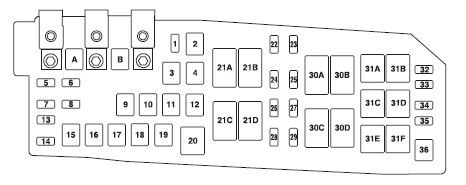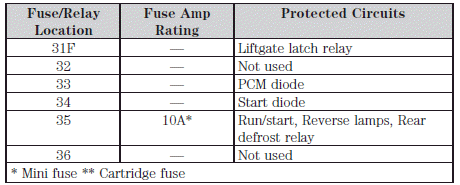 Ford Escape: Power distribution box
Ford Escape: Power distribution box
The power distribution box is located in the engine compartment. Refer to the Identifying components in the engine compartment section of the Maintenance and Specifications chapter for the location. The power distribution box contains high-current fuses that protect your vehicle’s main electrical systems from overloads.
![]() WARNING: Always disconnect the battery before servicing high
current fuses.
WARNING: Always disconnect the battery before servicing high
current fuses.
![]() WARNING: To reduce risk of electrical shock, always replace
the cover to the Power Distribution Box before reconnecting the
battery or refilling fluid reservoirs.
WARNING: To reduce risk of electrical shock, always replace
the cover to the Power Distribution Box before reconnecting the
battery or refilling fluid reservoirs.

The high-current fuses are coded as follows.



 Passenger compartment fuse panel
Passenger compartment fuse panel
The fuse panel is located on the
right-hand side of the center
console, by the instrument panel.
Remove the panel cover to access
the fuse cover. Press the tabs on the
top and bottom of the fus ...
 CHANGING THE TIRES
CHANGING THE TIRES
If you get a flat tire while driving, do not apply the brake heavily.
Instead, gradually decrease your speed. Hold the steering wheel firmly
and slowly move to a safe place on the side of the road ...
See also:
Luggage compartment
LUGGAGE COMPARTMENT LIGHT (If installed)
Luggage compartment light has a 3-position
switch. The three positions are:
o In the "DOOR" position, the luggage compartment
light comes o ...
Blizzard Conditions
Being stuck in snow can be a serious situation. Stay with the vehicle unless
there is help nearby. If possible, use the Roadside Assistance Program (U.S. and
Canada) on page 13‑7 or Roadside ...
Driving on snowy and icy roads
To prevent skidding and slipping, avoid
sudden braking, abrupt acceleration, highspeed
driving, and sharp turning when
driving on snowy or icy roads.
Always maintain ample distance between
yo ...
